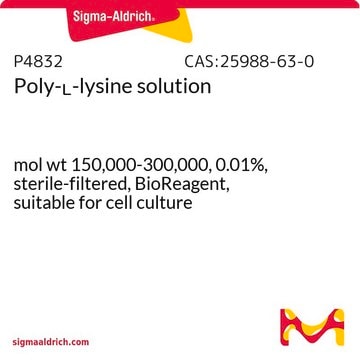The product is provided as a 0.01% sterile filtered solution in water. When coating slides with this solution, it is recommended to incubate for 5 minutes and allow the slides to dry at room temperature.
推荐产品
产品名称
多聚-L-赖氨酸 溶液, 0.01%, sterile-filtered, BioReagent, suitable for cell culture
無菌
sterile-filtered
品質等級
產品線
BioReagent
形狀
liquid
分子量
70—150 kDa
包裝
pkg of 50 mL
濃度
0.01%
技術
cell culture | mammalian: suitable
表面覆盖率
4 μg/cm2
雜質
endotoxin, tested
溶解度
water: soluble
運輸包裝
ambient
儲存溫度
2-8°C
SMILES 字串
N([C@@H](CCCCN)C(=O)N[C@@H](CCCCN)C(=O)O)C(=O)[C@@H](N)CCCCN
InChI
1S/C18H38N6O4/c19-10-4-1-7-13(22)16(25)23-14(8-2-5-11-20)17(26)24-15(18(27)28)9-3-6-12-21/h13-15H,1-12,19-22H2,(H,23,25)(H,24,26)(H,27,28)/t13-,14-,15-/m0/s1
InChI 密鑰
WBSCNDJQPKSPII-KKUMJFAQSA-N
正在寻找类似产品? 访问 产品对比指南
相关类别
一般說明
應用
生化/生理作用
成分
準備報告
未找到合适的产品?
试试我们的产品选型工具.
同類產品
相關產品
儲存類別代碼
12 - Non Combustible Liquids
水污染物質分類(WGK)
WGK 2
閃點(°F)
Not applicable
閃點(°C)
Not applicable
其他客户在看
商品
Poly-Lysine enhances cell binding with positively-charged surface ions, optimizing electrostatic interaction on culture surfaces for increased cell attachment.
3D细胞培养概述。了解2D与3D细胞培养的对比结果,3D细胞培养的优势以及可用于开发3D细胞模型的技术
3D cell culture overview. Learn about 2D vs 3D cell culture, advantages of 3D cell culture, and techniques available to develop 3D cell models
Cancer stem cell media, spheroid plates and cancer stem cell markers to culture and characterize CSC populations.
实验方案
Adhere cells to solid substrates using poly-lysine, which enhances electrostatic interaction between negatively charged ions of the cell membrane and the culture surface.
使用多聚-赖氨酸将细胞粘附在固相基质上,多聚-赖氨酸可增强细胞膜表面的负电荷离子与培养表面之间的静电相互作用。
-
When coating coverslips with item P4707, is it necessary to wash the reagent off after 5 minutes, or is there a different recommended procedure?
1 answer-
Helpful?
-
-
Is the product P4707 suitable for coating glassware for cell culture? Also, what is the difference between Poly L and Poly D lysine?
1 answer-
Yes, the product P4707 is suitable for coating glassware for cell culture. The difference between Poly L and Poly D lysine lies in their stereoisomeric properties. Poly-L-Lysine is a charge enhancer and can be used for coating many surfaces, including tissue culture plasticware and glassware. However, certain cells can digest poly-L-lysine, in which case the poly-D-lysine, such as P7405, should be used. This product can also be used to coat tissue culture plasticware and glassware.
Helpful?
-
-
How many times can it be reused?
1 answer-
The number of times that this product may be re-applied has not been determined. This would be dependent on several factors, such as surface area, material type, surface pretreatment, and incubation period. Please see the link below to review the product datasheet for additional information:
https://www.sigmaaldrich.com/deepweb/assets/sigmaaldrich/product/documents/244/731/p4707pis.pdfHelpful?
-
-
What is the molecular weight of product P4707?
1 answer-
Poly-L-lysine solution is 70-150 kDa molecular weight.
Helpful?
-
-
What is the protocol for using Product P4707, Poly-L-Lysine solution, to coat tissue culture plasticware?
1 answer-
A solution of 0.1 mg/mL is prepared; 0.5 mL of that solution is aseptically transferred to a non-tissue culture treated 25 square cm flask. The flask is gently rocked to evenly coat the surface. After five minutes, the excess solution is removed and the surface is thoroughly rinsed with sterile water and allowed to dry for several hours.
Helpful?
-
-
How can I sterilize slides coated with Product P4707, Poly-L-Lysine solution?
1 answer-
Poly-L-Lysine coated slides can be exposed to UV light overnight for sterilization.
Helpful?
-
-
Should I use Poly-L-Lysine or Poly-D-Lysine?
1 answer-
Certain cells secrete proteases, which can digest poly-L-lysine. For those cell types, poly-D-lysine should be used.
Helpful?
-
-
What is the concentration of Product P4707, Poly-L-Lysine solution?
1 answer-
This product is supplied as a 0.01% w/v solution.
Helpful?
-
-
What is the protocol for using Product P4707, Poly-L-Lysine solution, to coat slides?
1 answer-
For coating slides with poly-L-lysine, in general, it is recommended to use a 0.01% (w/v) solution. After a 5 minute incubation, the excess solution is removed and the slides are dried at room temperature or in an oven at gentle heat.
Helpful?
-
-
What is the Department of Transportation shipping information for this product?
1 answer-
Transportation information can be found in Section 14 of the product's (M)SDS.To access the shipping information for this material, use the link on the product detail page for the product.
Helpful?
-
Active Filters
我们的科学家团队拥有各种研究领域经验,包括生命科学、材料科学、化学合成、色谱、分析及许多其他领域.
联系技术服务部门





